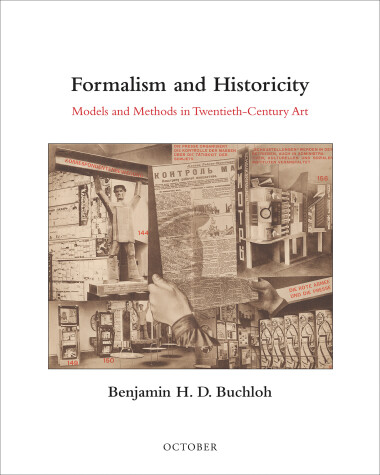October Books
2 total works
Some critics view the postwar avant-garde as the empty recycling of forms and strategies from the first two decades of the twentieth century. Others view it, more positively, as a new articulation of the specific conditions of cultural production in the postwar period. Benjamin Buchloh, one of the most insightful art critics and theoreticians of recent decades, argues for a dialectical approach to these positions.This collection contains eighteen essays written by Buchloh over the last twenty years. Each looks at a single artist within the framework of specific theoretical and historical questions. The art movements covered include Nouveau Realisme in France (Arman, Yves Klein, Jacques de la Villegle) art in postwar Germany (Joseph Beuys, Sigmar Polke, Gerhard Richter), American Fluxus and pop art (Robert Watts and Andy Warhol), minimalism and postminimal art (Michael Asher and Richard Serra), and European and American conceptual art (Daniel Buren, Dan Graham). Buchloh addresses some artists in terms of their oppositional approaches to language and painting, for example, Nancy Spero and Lawrence Weiner. About others, he asks more general questions concerning the development of models of institutional critique (Hans Haacke) and the theorization of the museum (Marcel Broodthaers); or he addresses the formation of historical memory in postconceptual art (James Coleman). One of the book's strengths is its systematic, interconnected account of the key issues of American and European artistic practice during two decades of postwar art. Another is Buchloh's method, which integrates formalist and socio-historical approaches specific to each subject.
These influential essays by the noted critic and art historian Benjamin Buchloh have had a significant impact on the theory and practice of art history. Written over the course of three decades and now collected in one volume, they trace a history of crucial artistic transitions, iterations, and paradigmatic shifts in the twentieth century, considering both the evolution and emergence of artistic forms and the specific historical moment in which they occurred.
Buchloh's subject matter ranges through various moments in the history of twentieth-century American and European art, from the moment of the retour à l'ordre of 1915 to developments in the Soviet Union in the 1920s to the beginnings of Conceptual art in the late 1960s to the appropriation artists of the 1980s. He discusses conflicts resulting from historical repetitions (such as the monochrome and collage/montage aesthetics in the 1910s, 1950s, and 1980s), the emergence of crucial neo-avantgarde typologies, and the resuscitation of obsolete genres (including the portrait and landscape, revived by 1980s photography). Although these essays are less monographic than those in Buchloh's earlier collection, Neo-Avantgarde and Culture Industry, two essays in this volume are devoted to Marcel Broodthaers, whose work remains central to Buchloh's theoretical concerns. Engaging with both formal and historical paradigms, Buchloh situates himself productively between the force fields of formal theory and historical narrative, embracing the discrepancies and contradictions between them and within individual artistic trajectories.
Contents
Formalism and Historicity (1977) • Marcel Broodthaers: Allegories of the Avant-Garde (1980) • Figures of Authority, Ciphers of Regression: Notes on the Return of Representation in European Painting (1981) • Allegorical Procedures: Appropriations and Montage in Contemporary Art (1982) • The Museum Fictions of Marcel Broodthaers (1983) • From Faktura to Factography (1984) • Readymade, Objet Trouvé, Idée Reçue (1985) • The Primary Colors for the Second Time: A Paradigm Repetition of the Neo-Avantgarde (1986) • Cold War Constructivism (1986) • Conceptual Art 1962–1969: From the Aesthetics of Administration to the Critique of Institutions (1989) • Residual Resemblance: Three Notes on the Ends of Portraiture (1994) • Sculpture: Publicity and the Poverty of Experience (1996)

